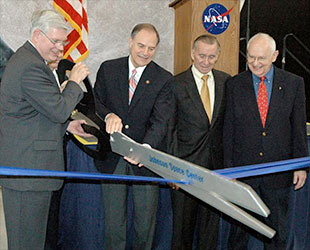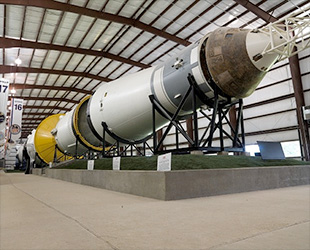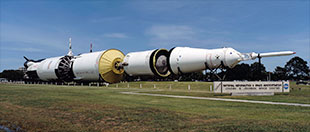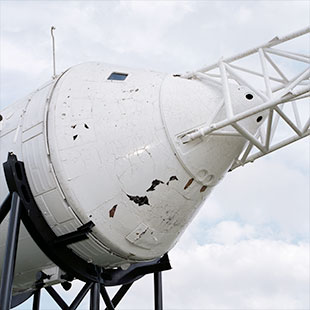 advertisements advertisements
|

|
Full Coverage: JSC Saturn V Restoration
'Houston, we have a restored moon rocket'

Johnson Space Center director Michael Coats, Congressman Nick Lampson and astronauts Walt Cunningham and Alan Bean cut the ribbon opening the Saturn V Facility in Houston. (collectSPACE) |
July 20, 2007 — With managers, moonwalkers and the media watching, NASA's Johnson Space Center opened Friday a facility designed to protect and display the last remaining 363-foot Saturn V rocket to be assembled from parts once capable of launching astronauts to the Moon.
"I think there is no more appropriate time to celebrate this historic spacecraft than on July 20, which is the 38th anniversary of the first footprints on the Moon," said Mike Coats, the director of Johnson Space Center and a former shuttle astronaut, in his welcoming remarks.
Together with Congressman Nick Lampson, Coats used an oversized pair of scissors to cut the opening ribbon.
"I think this is a magnificent national treasure that will stand here now for an awfully long time to come. I am proud to have played a little bit of a part in helping get it started," said Lampson.
The Saturn V is not new to the space center; in fact, it hasn't moved from where it currently rests since its arrival in Houston in 1977. For nearly 30 years, it sat on its side, exposed to the elements, from its parking space opposite the main entrance to JSC.
The passage of time, subjection to Houston humidity and the infiltration of local flora and fauna were not kind to the rocket, degrading it to the point of nearly being destroyed.
"It would be a real shame if no Saturn V survived and future generations had to rely on documents, films and motion pictures to appreciate the effort and achievements that was Apollo," said Allan Needell, who led the effort to "Save the Saturn" for the Smithsonian's National Air and Space Museum.
"In our view, it represents or symbolizes the enormous Apollo achievement perhaps better than any other object in the national collection," said Needell.
The Smithsonian, which owns the Saturn V and loans it back to NASA for display, began fundraising in 1999 for the rocket's restoration. Half of the $2.5 million required for preservation of the rocket came from a matching grant from the Save America's Treasures Program operated by the White House, National Park Service and the National Trust for Historic Preservation. The remaining funds were raised through donations from Boeing, Lockheed Martin, Houston Endowment, Halliburton and other organizations.
Conservation Solutions, Inc. was hired by the National Air and Space Museum to conduct the restoration, which began in March 2004 and took two years to complete. In addition to repairing the damage, the company returned the Saturn V to its original appearance, including restoring the rocket's original markings down to the smallest decal.
"This is the one in which we decided to do a historic preservation. So not only the final product, but literally every square inch of it was photographed and documented as a part of the process," Needell explained to collectSPACE. "So what we have is the best surviving example of Saturn V hardware that there is."
CSI also erected a climate-controlled building to protect and exhibit the rocket. The "temporary" facility, designed to stand for 10 years, shields the Saturn V from weather and the environment, while permitting visitors to tour the massive booster. NASA's exhibits department added turf under the rocket, a paved walkway, banners and displays to enhance the tourists' experience.
"It's very good to show people what we did. You know all these things on the wall that say what everyone did during the Apollo program, I think it's very important to do that. It's how you get kids turned on to science and engineering," astronaut John Young told collectSPACE. Young is one of only four astronauts to have launched on a Saturn V twice, including once to walk on the Moon.
Thirteen Saturn V rockets were launched between 1967 and 1973. Nine of those boosters took astronauts to the Moon; six of them to a landing on the lunar surface. The last Saturn V to leave Earth lofted the United States' first space station, Skylab.
To date, the Saturn V remains the most powerful rocket ever built. NASA's current plans for returning to the Moon include the construction of the Ares V rocket, which in addition to sharing a similar name, would stand as tall, if not taller than its predecessor and exceed its capability.
"It's a great challenge to try to do what these guys did, do it with modern technology, do it for a lot less money then they did it for, frankly," said Jeff Hanley, who is leading NASA's Constellation Program, to collectSPACE. "I think today's generation, what I'm finding, is a lot more ready for the challenge than maybe they would give themselves certain credit for."

Johnson Space Center's restored Saturn V rocket is the only one of three remaining to be comprised completely of stages built for spaceflight. (NASA) |
Two complete Saturn V rockets remained after the Apollo Program ended and NASA made the change to launching reusable space shuttles. Stages from both were used for JSC's display. Other flight stages were placed on exhibit by themselves and used to create a similar display at the Kennedy Space Center in Florida, in addition to replicas. A third Saturn V, also recently restored by CSI, resides in Huntsville, Alabama. Built to test the rocket with support facilities, Huntsville's Saturn V was never to fly in space.
"This is a future historical artifact for people from the 25th century to look back and say 'With the incredibly crude science of the 20th century, how did they manage to go the Moon?'" Skylab astronaut Joseph Kerwin said with a smile.
Johnson Space Center's Saturn V opens to the public at no charge beginning this weekend. The facility will remain open daily from 9:00 a.m. to 6:00 p.m.
Saturn rocket unwrapped for public tours
September 14, 2006 — Johnson Space Center's Saturn V rocket was reopened to the public on May 27, 2006. Kept off-limits for more than two years while its restoration and repair proceeded, the renewed rocket's debut was delayed even further as a result of the on-going work to prepare its temporary building for tourists.
The Saturn V was literally kept under wraps, translucent plastic covers, until only a few weeks ago while concrete sidewalks were laid and drywall walls were erected. The ground beneath the Saturn V was also provided a carpet of artifical turf and descriptive placquards were positioned along the length of the rocket.
The plastic now removed, visitors to the rocket park can walk alongside the Saturn and between its stages. Lights and windows illuminate the 363-foot booster, one of three remaining in existence.
Even as the public tours, work continues to beautify the surroundings. There are also rumors of a future expansion to make room for a souvenir shop and perhaps another, soon-to-be-retired launch vehicle: a space shuttle orbiter.
Click on thumbnails to enlarge
Full stack: Saturn V modules reattached
April 22, 2006 — Photographs posted to Johnson Space Center's website this week show that the restoration work on a Saturn V rocket is nearly complete.
Project Manager Melissa McKinley said of the progress depicted, "After three days of successful critical lifts at Rocket Park, all components are in place in the Saturn V display," referring to the final re-placement of the service module, the command module and launch escape tower.
Final painting of the rocket is now underway, which will be followed by building cleanup and final touchups. As earlier reported, the restoration is expected to be finished May 5.
Click on thumbnails to enlarge
Almost like old: rocket repair nearing end
April 4, 2006 — After two years, the repair and restoration of the Saturn V rocket at NASA's Johnson Space Center is nearing completion.
Click on thumbnails to enlarge
More photographs below.
"Everybody wants to know when it will be finished. I can tell you that [we] won't be here any longer than May 5," revealed Jee Skavdahl, Project Manager for Conservation Solutions, Inc., the company retained by the Smithsonian to conduct the restoration.
Skavdahl spoke of her and her team's experiences working on the Saturn V at a meeting of the American Institute of Aeronautics and Astronautics (AIAA) held in Houston last month.
"I realized [that the Saturn V] is the most magnificent example of disposable technology," said Skavdahl. "Disposable technology does not hold up well outside in a Houston climate and atmosphere with everything you have going on out there, between humidity, pollution and ozone. I tried to find the date that the styrofoam cup was made to see where it compares with the development of the Saturn V rocket and I couldn't find it, but I actually think the styrofoam cup, in some ways, would hold up better then what's happened to the rocket over the years."
Arriving in Houston in 2003, Conservation Solutions, Inc. (CSI) was faced with issues that could be traced back to the mid-1980s.
"Many of the holes that we found [identified] in the documentation from the mid-1980s and early 1990s are the same holes we found when we came back [to the rocket] in 2003," recounted Skavdahl.
"Within five years of the rocket being on site of Johnson Space Center, it started to show conditions and wear of the deterioration caused by the unique, or not-so-unique climate of Houston, Texas: very high temperatures, very high humidity, very high ozone concentration, salt [in the] air from being so close to the bay, [ultraviolot] exposure, microbiological organisms and animal infestation, which is my favorite," said Skavdahl. "We probably scooped out a whole roll-off dumpster of animal waste from the rocket. And it pretty much had to be done all by hand."
The 363-foot rocket posed a challenge due to its size.
"Conservation projects are small. They're small because a conservator's favorite tool is a toothbrush and dental pick," explained Skavdahl. "As much as I would love to tell you that we found this great way to mass produce and blow through all this conservation work, my techs do a lot of toothbrush and dental pick work. A lot of it."
To remove the multiple layers of paint that had been added to the Saturn V's three stages over the years, CSI developed a method using high pressure water jets. The technique served to be applicable to more than just the booster.
"While we were here in Houston, we brought 'Big Piece' here on site and used ultra-high pressure water jets, while we were water jetting Saturn V, we water jetted the RMS Titanic's "Big Piece" to break off the rust and corrosion," shared Skavdahl. The "Big Piece" is the largest piece of the sunken oceanliner recovered, weighing in at roughly 17 tons and measuring approximately 20 feet high by 25 feet wide.
The command module, where the crew would have been during launch, was also stripped of its paint but will not be repainted like the other stages.
"The command module will not be painted when its put back on its display stand. I think this will be the biggest shock to everybody that the command module will not be white. The white paint did not hold up well, the phenolic resin also expands and contracts, holding moisture in. There is a possibility that the Smithsonian will get a boost protective skirt made for it and then it will appear white," explained Skavdahl.
The command module was removed from its stand in May 2005. Upon its separation, CSI discovered that it could no longer be re-attached to the service module from where it had been.
"The struts that supported the command module that extended all the way through the service module were severely damaged. We are in the process of developing a new display stand that will put the command module back in the same place but it won't be re-bolted to the service module," said Skavdahl.
CSI is restoring the Saturn V so that it appears as it did the day it arrived at Johnson Space Center in 1977. In addition to repainting its transporter its original blue color, CSI restored the rocket's original markings down to the smallest sign, Skavdahl said.
"Decals were replaced as well as very, very small decals. If you were used to looking at the Saturn V, when the building opens and you can go back in, there are going to be words and lettering all over that haven't been on there for 20 years."
Once CSI is finished, the rocket and its housing will be the responsibility of Johnson Space Center's Exhibits Program. They will install description plaques, grass-like turf and other appearance improvements before opening the "temporary" building to the public. How temporary the building will be is yet to be seen.
"Its a temporary building for 10 years," replied Skavdahl to an AIAA member's question. "But I have been told, from various sources, that NASA has temporary buildings that have been here for 30 years, so I really don't know how long this building will remain. There are rumors of a convention center being built. There are rumors of an expansion to the [temporary] building. There was a rumor that they were going to paint a mural of the Saturn V rocket going down a whole side of the building, but that was going to cost half of a million dollars, so I don't think that is going to happen."
The following photographs were taken by collectSPACE during the week of March 27th.
Storm over, Saturn V repair to resume
September 29, 2005 — "Restoration has started on the Saturn V," reports Project Manager Melissa McKinley in an update posted to the Johnson Space Center's website. "All old paint has been removed down to the original metal surface on all sections. Three coats of paint have been placed on the stage 1 section (the first and largest section). The foam on stage 2 has been repaired and the entire section wrapped in a geo-textile fabric," continued McKinley.
Hurricane Rita's early projected path toward Houston, TX caused NASA to close Johnson Space Center last week, resulting in restoration work on the Saturn V being halted.
"Once the project remobilizes from the storm evacuation, work will begin with completion of metal repairs and finally painting," said McKinley.
McKinley added to the NASA report that the Command Module (No. 115) has now been restored to an historically accurate depiction.
Click on thumbnails to enlarge
JSC Saturn V restoration continues
August 22, 2005 — As this photo update from Johnson Space Center shows, restoration work continues on the massive Saturn V rocket at the NASA base in Houston.
Click on thumbnails to enlarge
JSC's Saturn V rocket under wraps
May 7, 2005 — Project Manager Melissa McKinley tells NASA JSC Features: "Work has started to demolish the existing sidewalks in the new building and pour new ones that extend out to the perimeter of the building," she said.
"The demolition and concrete pour will create dust and debris in the building... Because the Saturn V rocket, including the Service Module, has been cleaned of dirt, algae and other plant growth, it is currently protected with plastic wrap. This wrap will be removed when the interior building work is complete."
Click on thumbnails to enlarge
Servicing Saturn V's Service Module
March 16, 2005 — Progress continues on the restoration of Johnson Space Center's Saturn V rocket.
"The service module showed signs of structural damage within the interior of the stage," explains Project Manager Melissa McKinley on a JSC website. "[The SM damage] could not be evaluated without opening the panels."
"However, the panels were situated behind the support structure and could not be opened. The SM was lifted and set on a specially designed cradle for removal of the panels and structural investigation," continued McKinley.
Click on thumbnails to enlarge
Inside the Saturn V's Houston home
February 4, 2005 — After half a year of construction, the temporary home for Johnson Space Center's Saturn V is nearing completion. In an update posted to the Houston- based NASA center's website, Project Manager Melissa McKinley says that roof-panel installation and final power tie-in were both completed and that the 363-foot rocket's house should be done by February's end. "Installation of the windows will begin soon," said McKinley, "as will the setting of the air conditioning units."
Click on thumbnails to enlarge
Panels added to Saturn V building
October 7, 2004 — Work continues on the construction of the building around the Saturn V rocket at the entrance to NASA's Johnson Space Center in Houston, Texas.
"The sheeting phase of the building construction is underway," said Project Manager Melissa McKinley in an update posted to JSC Features, the online newsletter for center employees. "Wall sheeting will be followed by roof sheeting." Also scheduled are lighting, receptacle and fire alarm installation.
Click on thumbnails to enlarge
Saturn V building begins to take shape
July 29, 2004 — JSC Features, the online newsletter for NASA's Johnson Space Center employees, has again published a photo gallery documenting the progress being made on the restoration of the center's Saturn V rocket.
"Structural steel is laid out on the ground in preparation for steel erection of the temporary building over the Saturn V," said Project Manager Melissa McKinley. "A concrete grade beam can be seen around the perimeter of the work area, which shows the actual size of the building to be constructed."
Once columns are in place along this grade beam and are connected with wall girts, explains McKinley, "the roof sections seen in the photos will be lifted into place and then bolted to the columns. Sheeting on the sides and the roof will complete the exterior of the building."
Click on thumbnails to enlarge
Restoration of JSC's Saturn V proceeds
June 8, 2004 — JSC Features has posted photographs showing the progress made thus far on the restoration of NASA Johnson Space Center's Saturn V rocket.
Pictured are two stages of the project:
The addition of a new "Rocket Park" sign, and
The removal of the Launch Escape System (LES) and the Command Module (CM).
"CSI (Conservation Solutions, Inc.) removed these items to facilitate inspection and restoration," said Melissa McKinley, Project Manager. "The CM has been opened and inspected and is in good condition." The construction of the temporary building cover is also "progressing well".
Funds sought to restore Saturn V rocket

The vehicle at NASA's Johnson Space Center in Houston, Texas, is the only surviving Saturn V made up of stages and spacecraft all of which were intended to fly. (NASA) |
March 1, 2004 — The only remaining Saturn V rocket made completely from stages and spacecraft intended to launch Americans to Earth orbit and the Moon, is the focus of a major restoration effort to begin March 8 in Houston, Texas.
The 363-foot tall booster, which has lain on its side near the entrance to NASA's Johnson Space Center since 1977, has deteriorated due to exposure to the Houston area's regular high humidity, high ozone concentrations and chemical pollution.
"Protecting the Saturn V in Houston and providing public access to it is an important responsibility," said curator Allan Needell, who is leading the preservation effort at the Smithsonian's National Air and Space Museum.
The museum acquired the rocket from NASA in 1977 and loaned it to the Johnson Space Center for display. "Our mission is to preserve and memorialize the history of flight, and I can think of no more compelling task than ensuring that future visitors to the site of 'mission control' can see for themselves this irreplaceable machine and symbol of the Apollo era."
Half of the $2.5 million required for preservation of the rocket is available from a dollar-for-dollar matching grant from the Save America's Treasures Program, a public-private partnership that includes the White House, the National Park Service and the National Trust for Historic Preservation. More than $590,000 in matching funds has already been provided or pledged through the fundraising efforts of an independent committee in Houston.
An additional $540,000 is required to complete the preservation work.
Working with and for the Smithsonian, Conservation Solutions, Inc. (CSI) of Washington, D.C. will begin next week state-of-the-art research and testing of the Saturn V's materials to identify methods of preserving as much of the original rocket as possible.
CSI has experience restoring large historic structures, including the "Big Piece" recovered in 1998 from the R.M.S. Titanic.
CSI has also been contracted to design and construct a temporary housing structure to protect and display the rocket until a permanent home is constructed.
The funds yet to be raised will be applied to the extensive cleaning and treatment of the rocket's exterior.

Exposure to high humidity, ozone concentrations and chemical pollution has deteriorated the rocket significantly. (NASA) |
The project will restore hardware originally intended for four different missions. The first (S-IC-14) and third (S-IVB-513) stages were scheduled for the Apollo 18 or 19 lunar landings, both of which were canceled. The second stage (S-II-15) was meant as a backup to launch the first U.S. space station Skylab.
The rocket's crew vehicle (Command Module No. 115) was intended for an unspecified Apollo or Skylab flight.
Complying with Smithsonian standards, efforts will be made to preserve the authenticity and integrity of each artifact.
The Saturn V overall is in poor condition. Various external surfaces have suffered exfoliation of coverings and corrosion of internal and external structures. There is also a strong indication of moisture buildup within the vehicle.
Mold and plant growth on and in the vehicle indicates both excessive moisture collection and poor drainage throughout the rocket. Small animals have found shelter inside and are responsible for acidic debris and damage.

State-of-the-art research and tests of conservation methods will allow for the preservation of as much of the original material from the rocket as possible. (NASA) |
Assuming full funding, CSI will complete restoration of the Saturn V this year. Access to the Saturn V will remain free to visitors and the rocket will remain a stop along the tram tours run by neighboring attraction Space Center Houston.
The Saturn V in Houston is one of only three surviving vehicles remaining from those built to launch Americans to the Moon during the 1960s and 70s. Another, with mixed, flyable and non-flyable stages, was restored in 1995 and is displayed at the Kennedy Space Center in Florida. A local campaign to raise funds to restore the Saturn V "dynamic test vehicle" in Alabama is also underway. All three vehicles are in the Smithsonian air and space collection.
Public donations toward the restoration of the Houston Saturn V can be mailed to: National Air and Space Museum, Saturn V Fund, Independence Avenue at Sixth Street, SW, Suite 3700, MRC 321 P.O. Box 37012, Washington, DC 20013-7012. Checks should be made payable to: "National Air and Space Museum Saturn V". |

© 1999-2025 collectSPACE. All rights reserved.

|
|

|

|
